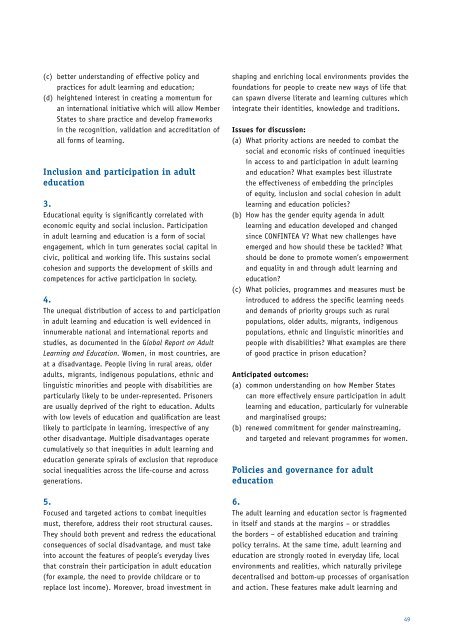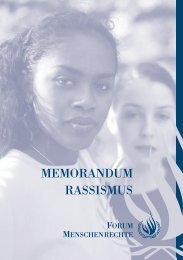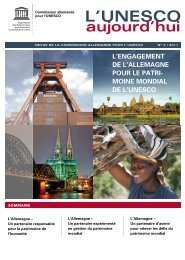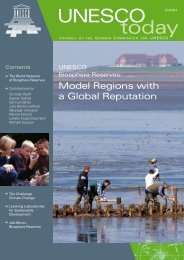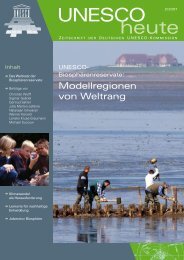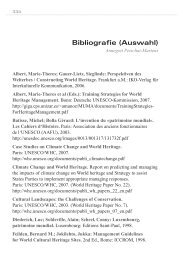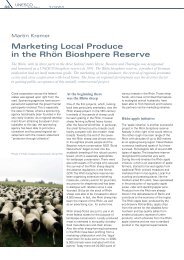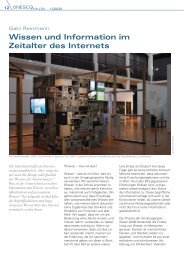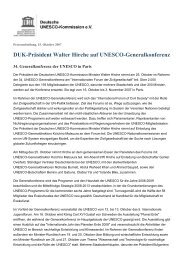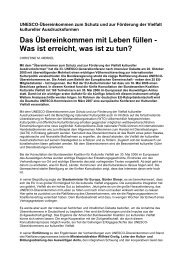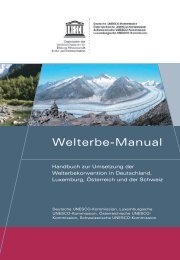CONFINTEA VI, final report - Unesco
CONFINTEA VI, final report - Unesco
CONFINTEA VI, final report - Unesco
Create successful ePaper yourself
Turn your PDF publications into a flip-book with our unique Google optimized e-Paper software.
(c) better understanding of effective policy and<br />
practices for adult learning and education;<br />
(d) heightened interest in creating a momentum for<br />
an international initiative which will allow Member<br />
States to share practice and develop frameworks<br />
in the recognition, validation and accreditation of<br />
all forms of learning.<br />
Inclusion and participation in adult<br />
education<br />
3.<br />
Educational equity is significantly correlated with<br />
economic equity and social inclusion. Participation<br />
in adult learning and education is a form of social<br />
engagement, which in turn generates social capital in<br />
civic, political and working life. This sustains social<br />
cohesion and supports the development of skills and<br />
competences for active participation in society.<br />
4.<br />
The unequal distribution of access to and participation<br />
in adult learning and education is well evidenced in<br />
innumerable national and international <strong>report</strong>s and<br />
studies, as documented in the Global Report on Adult<br />
Learning and Education. Women, in most countries, are<br />
at a disadvantage. People living in rural areas, older<br />
adults, migrants, indigenous populations, ethnic and<br />
linguistic minorities and people with disabilities are<br />
particularly likely to be under-represented. Prisoners<br />
are usually deprived of the right to education. Adults<br />
with low levels of education and qualification are least<br />
likely to participate in learning, irrespective of any<br />
other disadvantage. Multiple disadvantages operate<br />
cumulatively so that inequities in adult learning and<br />
education generate spirals of exclusion that reproduce<br />
social inequalities across the life-course and across<br />
generations.<br />
5.<br />
Focused and targeted actions to combat inequities<br />
must, therefore, address their root structural causes.<br />
They should both prevent and redress the educational<br />
consequences of social disadvantage, and must take<br />
into account the features of people’s everyday lives<br />
that constrain their participation in adult education<br />
(for example, the need to provide childcare or to<br />
replace lost income). Moreover, broad investment in<br />
shaping and enriching local environments provides the<br />
foundations for people to create new ways of life that<br />
can spawn diverse literate and learning cultures which<br />
integrate their identities, knowledge and traditions.<br />
Issues for discussion:<br />
(a) What priority actions are needed to combat the<br />
social and economic risks of continued inequities<br />
in access to and participation in adult learning<br />
and education? What examples best illustrate<br />
the effectiveness of embedding the principles<br />
of equity, inclusion and social cohesion in adult<br />
learning and education policies?<br />
(b) How has the gender equity agenda in adult<br />
learning and education developed and changed<br />
since <strong>CONFINTEA</strong> V? What new challenges have<br />
emerged and how should these be tackled? What<br />
should be done to promote women’s empowerment<br />
and equality in and through adult learning and<br />
education?<br />
(c) What policies, programmes and measures must be<br />
introduced to address the specific learning needs<br />
and demands of priority groups such as rural<br />
populations, older adults, migrants, indigenous<br />
populations, ethnic and linguistic minorities and<br />
people with disabilities? What examples are there<br />
of good practice in prison education?<br />
Anticipated outcomes:<br />
(a) common understanding on how Member States<br />
can more effectively ensure participation in adult<br />
learning and education, particularly for vulnerable<br />
and marginalised groups;<br />
(b) renewed commitment for gender mainstreaming,<br />
and targeted and relevant programmes for women.<br />
Policies and governance for adult<br />
education<br />
6.<br />
The adult learning and education sector is fragmented<br />
in itself and stands at the margins – or straddles<br />
the borders – of established education and training<br />
policy terrains. At the same time, adult learning and<br />
education are strongly rooted in everyday life, local<br />
environments and realities, which naturally privilege<br />
decentralised and bottom-up processes of organisation<br />
and action. These features make adult learning and<br />
49


